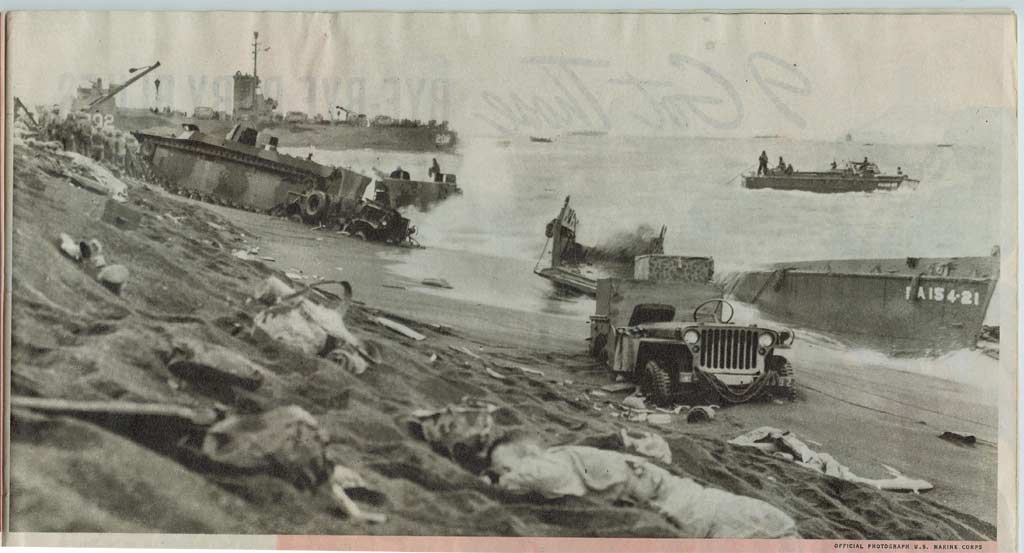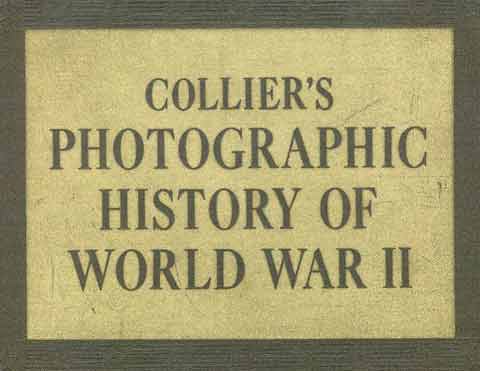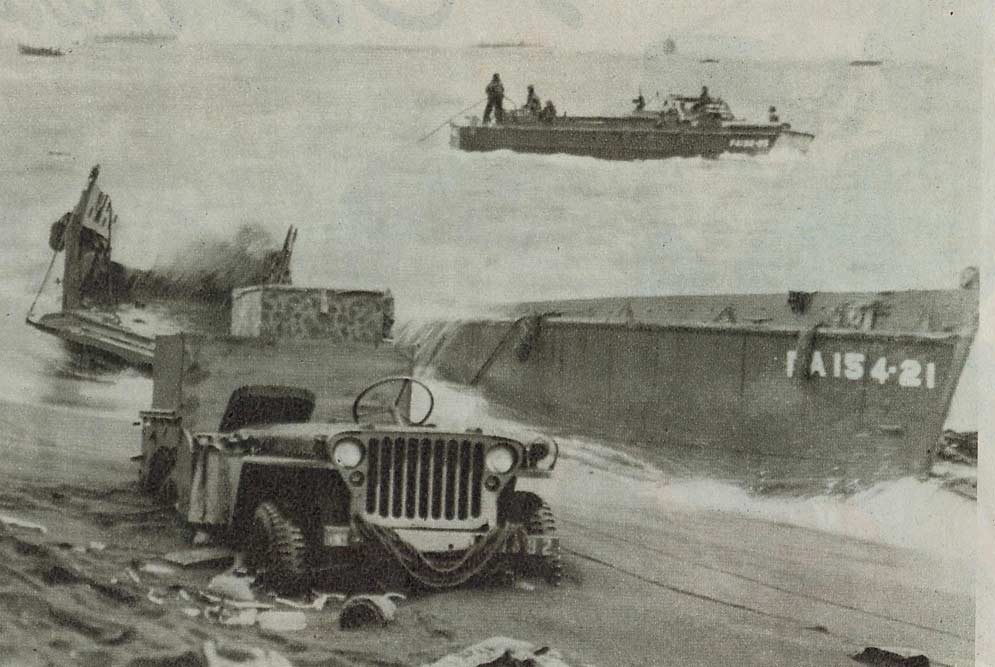USS Lowndes Boat (LCVP) stuck in the black sand of Iwo Jima
Colliers photo acquired by David Brinkman in an Auction in 2003

USS Lowndes Boat #21 (PA154-21)
In the summer of 2002, I talked to Lowndes' crewman James Ross about the Joe Rosenthal pillbox photo on Yellow
beach of Iwo Jima
(which my Dad had identified, in some notes, as the evacuation station area of the Lowndes). Mr. Ross
said the only nationally published photo involving the Lowndes (that he knew of) was
a photo that appeared in Colliers Magazine that showed one of the Lowndes landing boats
broached in the surf at Iwo Jima next to a jeep that was also stuck in the sand. Mr. Ross
said he lost the photo some years back. About a year after talking to Mr. Ross,
I came across a 1946 Colliers Book in an Internet auction (ebay) that included a collection of their photos from WWII.
I decided to bid on it and, being the only bidder, I got if for $10. When I received the
book, I went straight to the Iwo Jima photos and there it was... Just as Mr. Ross had described.
About a month after finding
this book I also located a copy of the original magazine with a larger photo and story about Iwo Jima.
 Above is the 1946 Colliers Book cover and below is the actual Colliers Magazine April 1945 issue (cover) that first published the photo.
The magazine photo was larger than the book photo and I've included the boat #21 portion of this larger photo below.
Above is the 1946 Colliers Book cover and below is the actual Colliers Magazine April 1945 issue (cover) that first published the photo.
The magazine photo was larger than the book photo and I've included the boat #21 portion of this larger photo below.
May 2005 update: This photo was taken by USMC Sgt. R. W. Hulstay, 5th Marine Division, photo# USMC 109604.
 In 2023, while working to identify the Lowndes exact location on Iwo's Yellow beach (that work can be found at this link), Boat #21 was noticed in the following photo:
In 2023, while working to identify the Lowndes exact location on Iwo's Yellow beach (that work can be found at this link), Boat #21 was noticed in the following photo:

The Amazing story of Boat #21 was documented 50 years after the war by the men who drove her to the Iwo Jima beach on D-Day. Below are those stories:
CLIFFORD SCHAFFER - Limeport, PA - "My Iwo Jima Memories." The morning of the attack, we were up before dawn. Ships and planes were shelling the island, all I saw was the outline of the island and smoke. I was the engineer on boat No. 21 on No. 4 hatch. We went over the side loaded with Marines and circled around waiting for orders to attack. When I saw all the smoke and heard the explosions, I thought nobody would be left alive on the island. (Boy was I wrong.) When we got the signal to attack all the boats lined up, and headed for the beach. When we hit the beach I dropped the ramp and the Marines disembarked with lots of shelling around us. We were broached and the ramp wouldn't go up. Ensign Chuck Munson was on my boat. Instead of being sitting ducks for the Jap mortars we abandoned the boat and got separated. At this point I was real scared, I remember wishing I was back in Limeport. Then I crawled up on the beach next to a Marine and said to him "This is real rough." He didn't answer me, I looked at him and he had been shot in the head. Then I saw a jeep bogged down in the sand nearby, I crawled to the side and used it for shelter. That was a terrifying night. The next day I saw a boat from the Lowndes, think it was No. 12. I got on and returned to the ship. I was then assigned to another boat. That night we were out and the "R" boat with an officer aboard ordered us to take our boat and scout the south end of the island and look for a disabled boat which we could not find. A ship nearby fired several shells over us into Mount Suribachi. The noise was the loudest thing I ever heard. Later we went back to look for the Lowndes, but could not find it. Another boat informed us that it might have gone out for night retirement to avoid an attack. We were told there was a supply ship where we could get fuel for our landing craft. We found the ship and they threw down two lines and we tied up. I filled both tanks, they asked us to come aboard for a hot meal. We climbed up the lines and had a hot meal and an apple. It was a storage apple but I had not had an apple for such a long time and it sure was a treat. The next day we located the Lowndes and loaded on supplies to take to the beach. On our return trip we took on wounded troops and brought them back to the Lowndes. It was an experience I will never forget. When I saw the American Flag on Mount Suribachi it lifted my spirits.
CHUCK MUNSON - Bettendorf, IA - My recollection of the Iwo Jima invasion begins when we left Eniwetok harbor, not yet knowing our destination until the Intelligence Officer f'unveils" a scale model of Iwo Jima on deck. We were shown the typographical highlites, such as the 3 air fields at Mt. Suribachi, and the cave areas. Iwo was 660 miles from Tokyo. The boat group officers were assigned 8 LCVP's to compile a wave and assigned a beach. Ours was Yellow Beach. We were issued detailed information on Iwo Jima to study. However, we were not prepared for the sand on Iwo Jima. It was black, course, and unstable, not the typical sandy beach. On February 19, 1945, as we arrived at our destination, we were awakened at about 2:30 AM for a steak and eggs breakfast (our last meal?). The yellow wave crew made their LCVP' s ready and then we received the long awaited order "Lower boats". The marines on board were seasick and relieved to disembark into the LCVP's and not as concerned about their future. The boats were loaded and we proceeded to the signal vessel and waited for our yellow flag to be lowered. While we circled we were bracketed with 2 mortar shells, so using good judgment we got the hell out of there. Then our signal was given to proceed to the "Yellow beach two" following the amtracks. (They looked so low, I feared they might sink.) The Beach Party had done its job marking our beach and we could see the enemy fire coming from Mt. Suribachi and from the airport area. We plunged ahead and hit the beach. We couldn't lower the ramp all the way because there were troops still on the edge of the water! We unloaded and one of our passengers, a seaman from the Lowndes, embarked with the troops and ran toward the airfield, we tried to stop him without success. I don't know who he was or if he returned to the ship. Our wave then returned to the ship to unload ammunition for the troops. As we unloaded, a shell fragment struck my life preserver cutting it in half and a small fragment ended up in my right leg. (I didn't realize this until I got back to the ship!) On our 2nd supply run, our LCVP broached and no one was there to help us. We couldn't get our ramp up due to the mortar hit so we "Abandoned ship" on "D" Day at dusk on Iwo Jima beach. I'm not certain how my crew got back to the ship, but I spent the night using whatever LCVP I could commandeer to bring wounded to the hospital ship. We ran under the heavy guns of the battleships, cruisers and the mortar fire from the beach. Thankfully, when dawn arrived and I could see the good ole APA 154 drop its anchor, I was able to get my substitute "Crew" to take me back to my "Home on water". I was excited in anticipation of the homecoming. Many thought Ensign Munson was a goner! I had a welcoming committee with lots of hugs and handshakes. Thank you God for my safe return! I retired to my cabin and when I removed my shoe it was full of dried blood from the small shrapnel hit on the beach. I went to sick bay and passed through the ward room which was full of severely wounded marines. I silently retired to my cabin and dressed my own wound. That was enough excitement for awhile . and I returned to my duties as assistant communications officer. The Navy finally discovered that the wrecked Jap boat was being used as a spotter station and it was finally destroyed. We could watch the progress of our troops on the beach and see them scale Mt. Suribachi. Then someone yelled "The stars & stripes have been raised on top of Mount Suribachi1" We witnessed this historic sight and thanked God for Victory! The whole crew cheered! The mopping up operations took several more months but the Lowndes had more work to do at Okinawa.

Return
to the USS Lowndes War Pictures Page
Return
to the Main USS Lowndes Page


 Above is the 1946 Colliers Book cover and below is the actual Colliers Magazine April 1945 issue (cover) that first published the photo.
The magazine photo was larger than the book photo and I've included the boat #21 portion of this larger photo below.
Above is the 1946 Colliers Book cover and below is the actual Colliers Magazine April 1945 issue (cover) that first published the photo.
The magazine photo was larger than the book photo and I've included the boat #21 portion of this larger photo below.
 In 2023, while working to identify the Lowndes exact location on Iwo's Yellow beach (that work can be found at this link), Boat #21 was noticed in the following photo:
In 2023, while working to identify the Lowndes exact location on Iwo's Yellow beach (that work can be found at this link), Boat #21 was noticed in the following photo:
